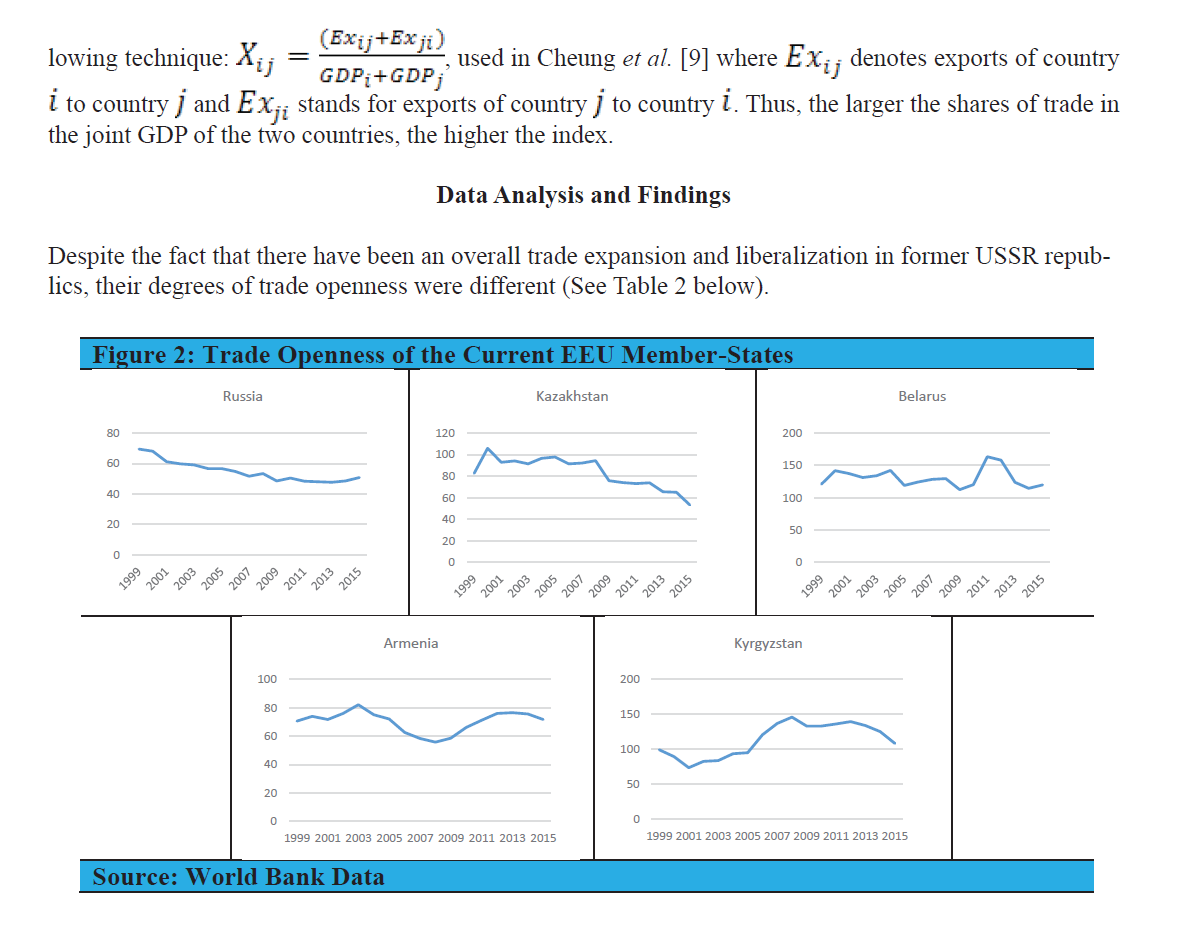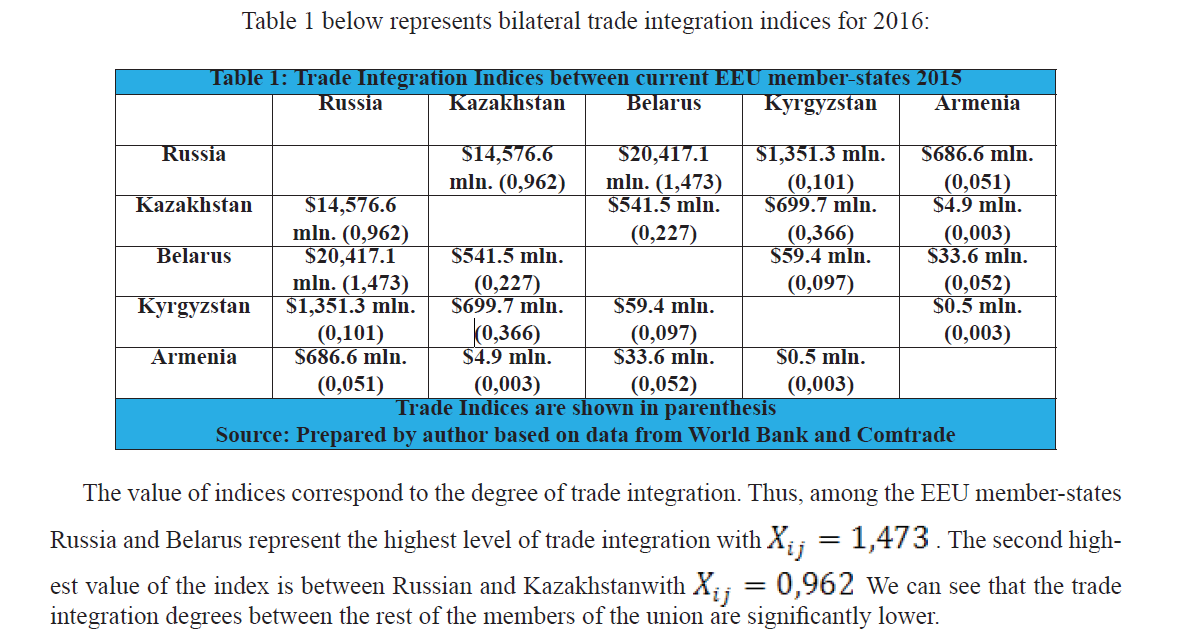Abstract
This paper presents and analysis of bilateral trade integration of the member-states of the Eurasian Economic Union (EEU). The analysis covers a period from 1999 to 2015. The index of trade integration is used as a measurement technique. The findings reveal that during 1999-2015 bilateral trade integration indices were different. Russia became less integrated in terms of trade with two other major member-states of the EEU Kazakhstan and Belarus. The bilateral trade indices of Kyrgyzstan and Armenia with other EEU members present irregular patterns with high fluctuations. Moreover, these newly admitted members of the EEU turn out to be much less integrated with other members of the union. The EEU, in general, became less integrated during the sample period.
Introduction
The creation of the Customs Union between Russia, Belarus and Kazakhstan in 2011 and its subsequent transformation to the Eurasian Economic Union (EEU) with accession of Kyrgyzstan and Armenia in 2015 was one of the major integrational events in Eurasia. Unlike other economic integrations, the current members of the EEU once were parts of a single state. Between 1991 and 2011, all the current EEU members had different and varying degrees of trade cooperation and preferential trade regimes. On the other hand, at the beginning of 2000 s, many of the current EEU member-states were characterized by trade liberalization with bursting exports and increasing trade with the other countries. During the period of 2003-2008, Kazakhstan’s trade increased several times through trade liberalization, inflow of investments, improving property rights and transportation infrastructure. The rapid growth of trade, however, was based heavily on oil industry [1]. In the early 1990 s, the trade relations between the current EEU members weakened as a result of increasing trade liberalization with the rest of the world and the deep economic recession (Asian Development Bank, 2006). On the other hand, trade relations among CIS and current EEU member-states improved due to general economic recovery, special trade regimes and reduction in costs of trade. The period from 1999 to 2008 was characterized by rapid economic growth that also resulted in a rapid growth of trade between the current members of the EEU. The crisis of 2008 caused considerable contraction of trade, which eventually recovered by 2011
Methodology and Literature
As it was already mentioned, the case of the economic integration under the EEU is a rather unusual case. A number of studies were done covering the process of the Eurasian economic integration. Karliuk in his study on the institutional structure of the EEU mentions that the integration process between Russia, Kazakhstan and Belarus are going at a rapid pace [2]. His evaluation of the institutional structure and legislative framework of the union can be understood as positive.
Interestingly, despite academic and policy interest there is still nosystematic and standard index of regional integration [3]. On the other hand, De Lombaerde, Dorrucci, Genna, and Mongelli state that “only a few attempts have been undertaken to design composite indices of regional integration and no proposal has been systematically and continuously used as a policy tool [4].
Mazhikeyev and Edwards [5] contrasting their finding to those of Head and Mayer [6] reveal that the trade turnover between the Central Asian countries and their colonizer Russia has been steadily increasing contradicting to Head and Mayer [6] who conclude that a country’s trade with the colonizer, typically, erodes by 60% after 30 years of independence.
Vicari [7] notes that the process of regional economic integration in the post-Soviet space was initiated almost at the same time when the USSR collapsed. It started with the establishment of the Commonwealth of Independent States (CIS) and was followed by regional initiatives-which were led by the Central Asian republics and the CIS sub-regional projects, driven by Russia. However, he claims that many of these projects failed in terms of institutional design.
Findings of Magilevskii [8] also points to a growing degree of trade integration. Thus, during the functioning of the Customs Union between Russia, Kazakhstan and Belarus, the trade turnover between Kazakhstan and Russia increased by 28% during 2010 and 2011.
Although there are studies that mention the integration between the current EEU member-states in various contexts, the literature that attempts to evaluate or quantify the degree of economic integration between the EEU member-states is lacking. As matter of common sense, we take trade integration as the most straightforward indicator of economic integration. In order to measure the trade integration, we use the following technique:, used in Cheung et al. [9] where denotes exports of country to country and stands for exports of country to country. Thus, the larger the shares of trade in the joint GDP of the two countries, the higher the index.
Data Analysis and Findings
As we can see in Figure 3, there is no generalized trend for all cases of bilateral trade. In many cases, there were great fluctuations in bilateral trade integration. The two largest trade flows of Russia-Belarus and Russia-Kazakhstan show gradually decreasing levels of trade integration. Interestingly, the trade integration index between Russia and Kazakhstan during 2009-2015 shows no significant change. The trade integration between Russia and the two other smaller members of the EEU Kyrgyzstan and Armenia show much greater fluctuations. However, in both cases there is an ascending trend from 1999 to 2007 and after 2011. The trade integration index between Kazakhstan and Belarus also shows great fluctuations. However, is also reproduces the same pattern, which indicates a rising trade integration between 1999 and 2007. After the crisis of 2008-2010, the trade integration index between Kazakhstan and Belarus recovers rapidly. The trade integration index between Kazakhstan and Kyrgyzstan is more similar to those between RussiaKazakhstan and Russia-Belarus. The changes of the trade index between Kazakhstan-Armenia, Belarus-Kyrgyzstan and Kyrgyzstan-Armenia present very irregular patters whereas in case of Belarus-Armenia there is an increasing trend over the sample period.
The graphical representation of the index throughout the period of 1995-2016 is shown in Figure 2 below:
In order to have a look on a general pattern of integration in the EEU, we plotted the change of the joint integration index dividing the sum of all mutual trade flows between the current EEU members to the sum of their GDP. The shape of the graph is similar to the shape of integration index between Russia and Kazakhstan, which is due to a relatively large share of the given trade flow in the mutual trade inside the EEU. Thus, there is a descending trend over the course of the period under consideration. Thus, since 2000 the current members of the EEU are gradually becoming less integrated in terms of trade. There is also no considerable increase in trade integration in the EEU after 2011 despite the fact that every year, the trade turnover between the countries is growing, and active works are carried out to harmonize the legislation and simplify the mechanisms of cooperation between the residents of the partner countries [10].
Table 1 below represents bilateral trade integration indices for 2016:
The value of indices correspond to the degree of trade integration. Thus, among the EEU member-states Russia and Belarus represent the highest level of trade integration with. The second highest value of the index is between Russian and Kazakhstanwith We can see that the trade integration degrees between the rest of the members of the union are significantly lower.
The trade integration of Kazakhstan with the rest of the EEU member-states was different in each case. The integration index for Kazakhstan was, however, more descending over the course of the sample period. The countries do not show an immediate increase in trade integration right after being admitted into the EEU except for Armenia. Since 1999, the members of the union are on a path of trade disintegration. Even after 2015, there is no sign of bursting trade integration between the EEU member-states. This sounds logical since the trade turnover between the members of the union is still falling. For instance, in 2016 the mutual trade between the EEU member-states has fallen by 6.6%.
Concluding Remarks
The analysis shows that the degree of bilateral trade integration between the current members of the EEU did not increase significantly since the creation of the Customs Union in 2011. In fact, they were more integrated in terms of trade in early 2000s than they are now. The measurement technique used in this analysis shows that the trade integration between the current members of the EEU was different since 1999. Particularly, the trade integration between the founding members of the Customs Union, which are Russia, Kazakhstan and Belarus, was much greater than that of Kyrgyzstan and Armenia, which became EEU members in 2015. In general terms the EEU has become less integrated over the course of the period from 1999 to 2015. In particular, trade relations of Russia with other two founding members of the EEU became smaller relative to their GDP size. The effect of the accession of Kyrgyzstan and Armenia to the union on the trade integration of the EEU is dubious. The trade integration of Russia with Armenia and Kyrgyzstan shows an ascending trend. However, the trade integration of these two newly admitted members of the union with Kazakhstan and Belarus is unclear.
The EEU is highly disproportionate in terms of trade flows and degree of trade integration between its member-states. Russia and Belarus present the highest degree of trade integration. The three founding members of the EEU Russia, Kazakhstan and Belarus appear to be highly integrated with each other in terms of trade whereas Kyrgyzstan and Armenia turn out to be less integrated in terms of trade. Kyrgyzstan is more integrated with Kazakhstan than with other members of the union. Armenia presents the lowest degrees of trade integration with its EEU partners.
The effect of the trade slowdown that persists since late 2014 on the bilateral trade integration between the EEU member-states is very weak and cannot be considered as significant. Although the mutual trade turnover of the EEU member-states is clearly decreasing since 2014.
References
- World Bank 63435 Trade Expansion through Market Connection, The Central Asian Markets of Kazakhstan, Kyrgyz Republic, and Tajikistan-2011. URL: http://econpapers.repec.org/bookchap/wbkwbpubs/2333.htm, Accessed: 26.01.2017.
- Karliuk, Institutional Structure of Eurasian Integration // Studies & Analyses #05 -2012p.2-12.
- Rayp, and Standaert, S. Measuring Actual Economic Integration // UNU series on regionalism – 2016.
- De Lombaerde, E. Dorrucci, G. Genna, and P. Mongelli. Quantative monitoring and comparison of regional integration processes: Steps towards good practice // UNU-CRIS Working Papers – 2008 p.149-179
- Mazhikeyev, and Edwards T.H. Central Asian Trade Relations in the Post-Soviet Era // Economics Discussion Paper Series (02) – 2013 – p.1-41
- Head, , Mayer, T. and Ries, J. The Erosion of Colonial Trade Linkages After Independence // Journal of International Economics, Elsevier – 2010 Vol. 81(1), p.1-14.
- Vicari, S. The Eurasian Economic Unionapproaching the economic integration in the post-Soviet space by EU-emulated elements // Papers in Political Economy (55) – 2016 p. 1-16
- Magilevskii, Trends and patterns in foreign trade of Central Asian countries // World Commerce Review-2012Working Papers no. 1. p.12-17.
- Cheung, W., Yiu. M.S. and Chow, K.K. Measuring economic integration: the case of Asian economies // BIS Papers (No 42).-2008.p.136-158.
- Zhanakova, N.N. Foreign Trade of the Republic of Kazakhstan with the Member States of the Eurasian Economic Union: State and Perspectives // International Journal of Economics and Financial Issues, 2016, 6(1), p.308313.



